Secret castles in Provence – 10 Hilltop Ruins to Discover in France
I once read somewhere that there were “no impressive castles in Provence”. And while I understand where the writer was coming from with this sentiment, after 3 years in the region, I now realise it really depends on your interpretation of impressive.
While it’s true that many of the most beautiful castles reside in other parts of France, Provence is a place of immense history and drama, and our castles (or what remains of them) reflect this beautifully.
The castles in Southern France are generally not in the same league as the likes of Chantilly or Versailles in the north, but they have their own unique charm and plenty of stories to tell.
The ten Provence châteaux highlighted in this list are those that are loved by locals in the know, but rarely receive the attention of visitors to the region. They’re the evidence of turbulent times past, and usually, places of stunning natural and historical beauty. And sometimes, they can be a little hard to find.
So let me help you discover these secret châteaux of Provence, France.
Looking for more Provence travel inspiration? Don’t forget to join our free Facebook group Provence Travel Planning!
Ten Provence Castles to Explore
There are dozens of castles in Provence. Seemingly every hilltop village and rocky spur is topped with the telltale signs of the region’s imperial past. However, some are now privately owned, many are unsafe to visit, and other’s have been made into tourist attractions to require a fee to visit (e.g. Château des Baux de Provence).
The following French châteaux are special in that they’re either secluded, largely undiscovered, or places of immense historical significance. Enjoy getting to know this lesser-known side of Provence!
CHÂTEAU DE VERNÈGUES
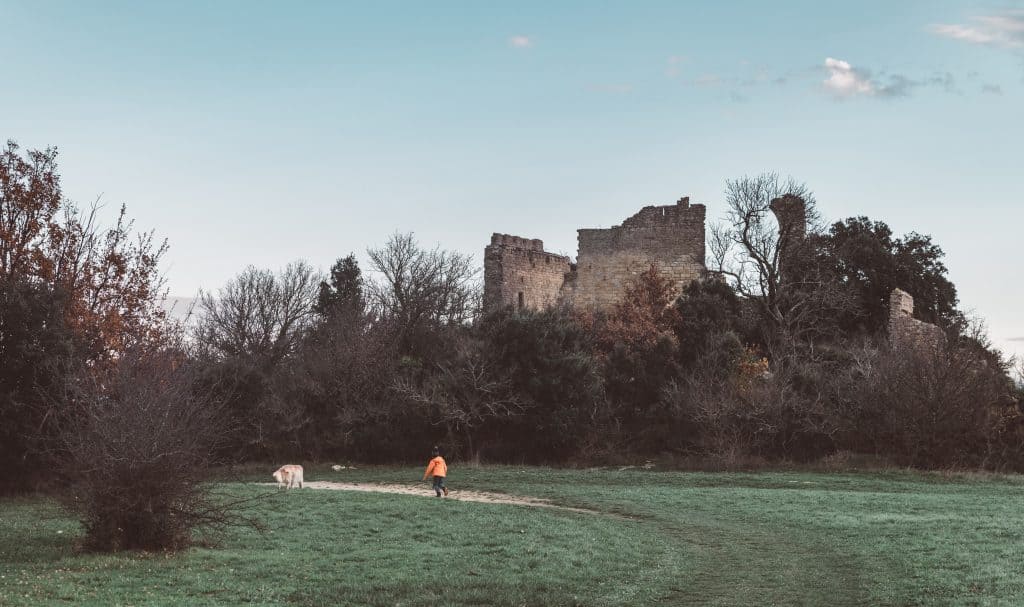
One of our absolute favourite walking spots in Provence, the Vernègues castle is situated at one edge of a raised plateau.
As with others in the region, the former village of Vernègues was destroyed by natural disaster. In June 1909, the village was flattened and later rebuilt on the more stable ground further down the hill. Today all that remains of the ‘Vieux Vernègues’ are the château walls and the ghostly stone structures of a few village dwellings.
While the castle itself is unsafe to investigate at close quarters (due to the unstable nature of the structure), there are still plenty of nooks and crannies to discover. Descend ancient staircases into underground caves, climb through low slung doorways for exceptional views, and marvel at how grand the hilltop château must have once looked at the helm of the village.
Despite its deteriorated state, it’s an imposing sight and must have made quite a statement when it was built in the middle ages.
How to reach the Château de Vernègues
Driving through Vernègues, you will see a sign in the direction of Vieux Vernègues. Follow the aptly named Rue du Vieux Vernègues as it snakes up the hill before branching out to the left of the château. It’s here you’ll find a large unstructured parking lot.
Leave your car here and proceed on foot for the final 120 meters to the entrance of the site. Then you can follow the wider gravel path around the site, or take one of the well-trodden paths that stem off the main route to discover the hidden caves and houses on your way up the hill. I’d recommend the latter!
Once you reach the plateau, take your time to explore the various pathways which will lead you to an orientation table, and an incredible view over the village of Alleins (where there is another castle to discover, see below). And on the way back down, be sure to take the small detour to the Église Saint Jacques which is stunning in its semi-ruined state.
CHÂTEAU D’ALLEINS
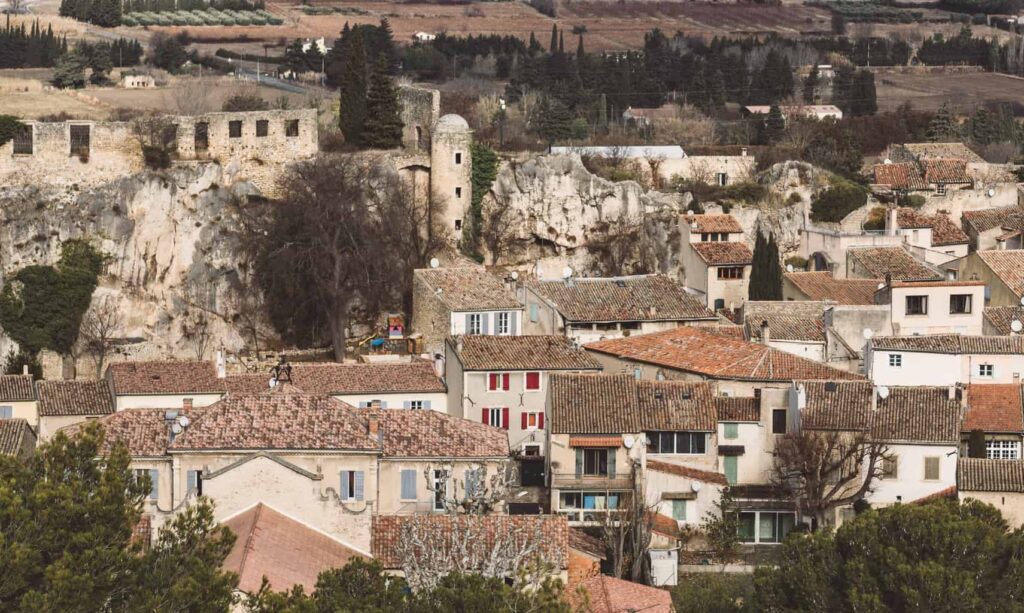
Driving north into Alleins from Vernègues, you are greeted with the most picturesque view of this small Provençal village.
Pastel coloured townhouses huddle around a barren hill, atop of which you’ll find the stately remains of the Château d’Alleins. Once a castle fit for the noble Renaud family, the château walls now house more pigeons than people, but you can still make out the general shape and structure of the 15th-century building.
Alleins itself is a severely underrated gem of a village. It’s one of those few villages in Provence that goes undetected by tourists, and yet it’s absolutely littered with unique and well-restored relics dating back as far as the 10th century. Indeed, before the most recent castle was built for the Renaud family, there is evidence another castle once lived on the same spot around 500 years earlier.
If you pop onto the village website you can download a walking map (in French) of the various ancient attractions including beautiful old mills, churches and le donjon which now houses a restaurant.
How to find the Alleins castle
If you find yourself in Alleins, you won’t be able to miss the château! There are many ways to access it, and once you do you’ll be rewarded with a stunning view of the village.
The most ‘official’ entrance to the castle is up a cobbled walkway from either Rue de la Liberté or Rue de la Fraternité. But you can also walk up the grassy bank opposite the SPAR on the main street. It’s a short walk to the castle but one worth doing to explore this ancient site unlike any other.
CHÂTEAU DE ROGNES
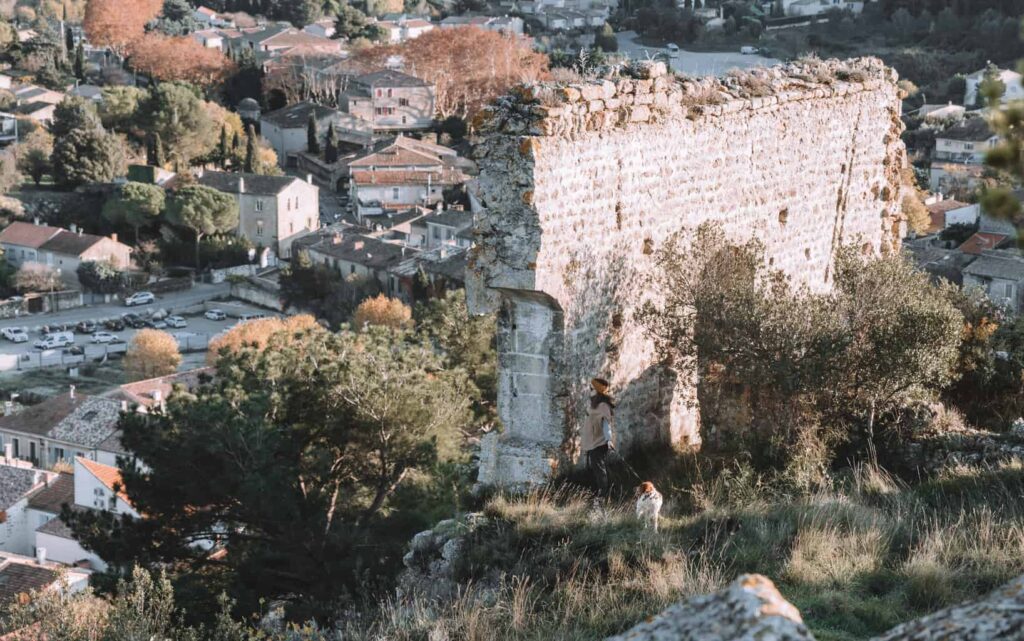
The original Rognes settlement was situated on the slopes of the Foussa – the small hill at the centre of the village. A grand château stood at its centre until it was dismantled during the 16th century. Now, all that remains of this original village are the castle ruins and, further down the hill, a few lucky houses that escaped total collapse. But the history of Rognes dates back much further and there is evidence of human habitation in this area since the Iron Age.
Despite its turbulent past, Rognes has prospered and become a popular village in Provence, in part due to its proximity to Aix-en-Provence and the Luberon. As you wander through the old town, the castle ruins at the top aren’t immediately obvious. But once you find the discreet path that leads up the Foussa to the ruins you’ll be rewarded with a stunning view over the village, nearby farms and the Luberon Valley in the distance.
How to reach the Rognes Castle
There are two clear walking paths up the Foussa to the old village. The first, off Avenue des Cegares, is easily missed. Little more than a skinny dirt track, you need to keep a lookout for it as you enter the avenue.
This path will lead you up the hill, past ruined dwellings and crumbling caves, under the last remaining wall of the château, and up to the crest. Here you can climb the rocky spur for a better vantage point, discover the castle ruins, and enjoy the uninterrupted views.
The other ‘official’ way up to the Vieux Rognes is at the end of the Avenue de la Campanette, although there are plenty of small tracks and routes to explore. Just watch your step, as it’s steep in places!
VIEUX VILLAGE DE MÉRINDOL
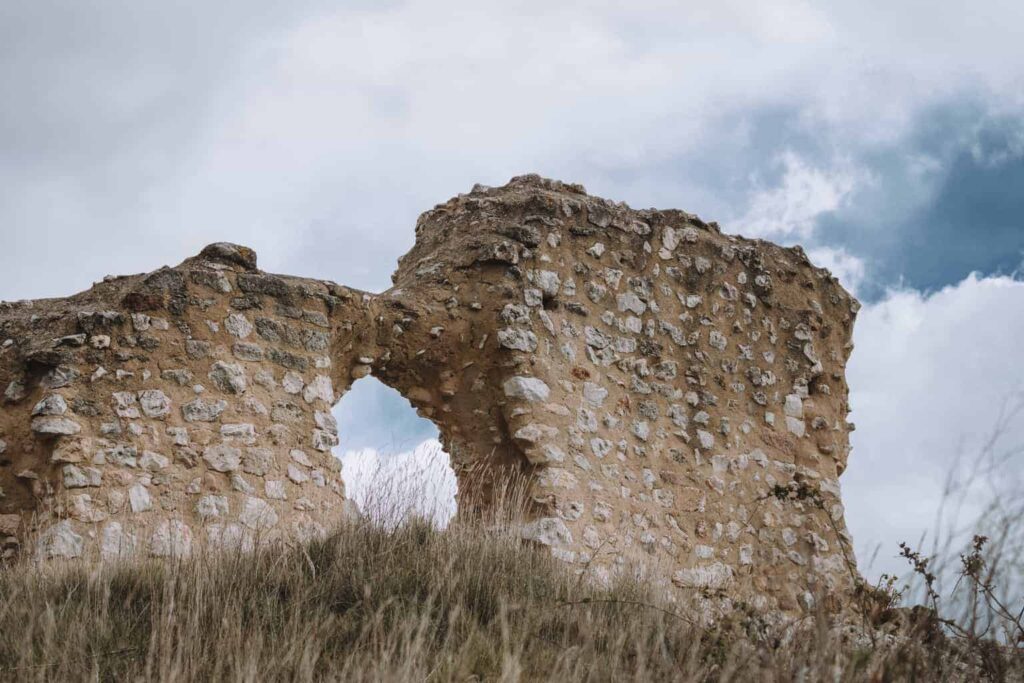
Above the present-day village of Mérindol lies the remains of another, much older village. Although it sustained significant damage during the religious wars in the 16th century – making the village uninhabitable – what was left behind has weathered the years remarkably well.
Here, unlike in some of the other ruins of Provence, you’ll find a series of structures that still somewhat resembles a village. Doors, walls and cobbled alleyways lead you through the maze of stonework to the castrum at the top.
Unfortunately, the château itself has borne the brunt of the damage, and all that remains is are a couple of walls that frame the craggy cliffs behind the village. The surrounding countryside is beautiful and you won’t be wasting your time with the short walk to the top. You’ll also find an orientation table to get your bearings of the Provençal landscape.
How to get to Vieux Mérindol
The most obvious, and convenient way to access the old Mérindol castle and village is at the edge of the newer village. Park at the village parking lot at the end of Rue des Cigales and follow the path up through the olive grove. There’s a large green sign to direct you, so you’re unlikely to get lost. This will lead you up to Chemin de l’Apied where you can start your exploration of the site. Don’t try to drive closer as the roads are very narrow with little options for turning around if you find yourself stuck!
An alternate route, and the one we took the first time we visited, is to drive up Chemin du Maou Traou before turning right onto a small gravel road. It’s a private road, but there is a cleared area of bush where we parked the car. From here, you follow the road into the bush before joining the path to the castrum. As seen on the map above.
LA QUILHO (LA QUILLE) DU PUY SAINTE RÉPARADE
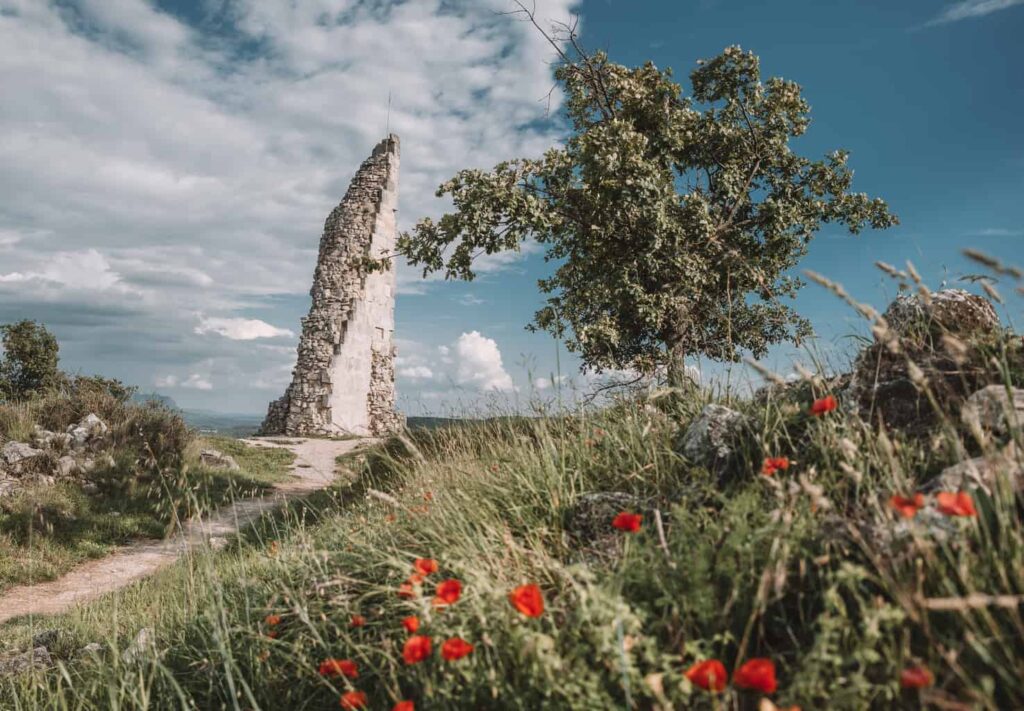
Another victim of natural disaster, this medieval castle survived years of political and religious unrest before being all but destroyed in the 20th Century. The 1909 earthquake reduced it to a lone tower (the keel), and 70 years later that was struck down by lightning!
The town rebuilt la quille in 1994 and it’s this reincarnation that you’ll visit today. But you’ll still need to use your imagination a fair bit to understand what these castle ruins once looked like.
The oppidum that houses the keel is in arguably better condition, despite its age. Dating as far back as the 4th century BC, it was occupied again in the Middle Ages, when the walls were rebuilt. These ramparts circle the hill creating terraces and natural walkways. It’s a charming site to walk through, one which many visitors to Provence are yet to discover.
How to reach La Quilho
La Quilho is situated overlooking the small hamlet of La Cride, just a short distance from the famous Château la Coste. To reach the oppidum and the keel, turn into Chemin de St Jean off the main road.
Take care if you’re travelling from the South, as it’s just around a narrow bend and you’re likely to miss it! This street will take you all the way to the beginning of the walk where you can continue by foot to explore the ancient hilltop settlement. This walking map will explain the route further and give directions to the keel and the orientation table.
CHÂTEAU D’EYGALIÈRES
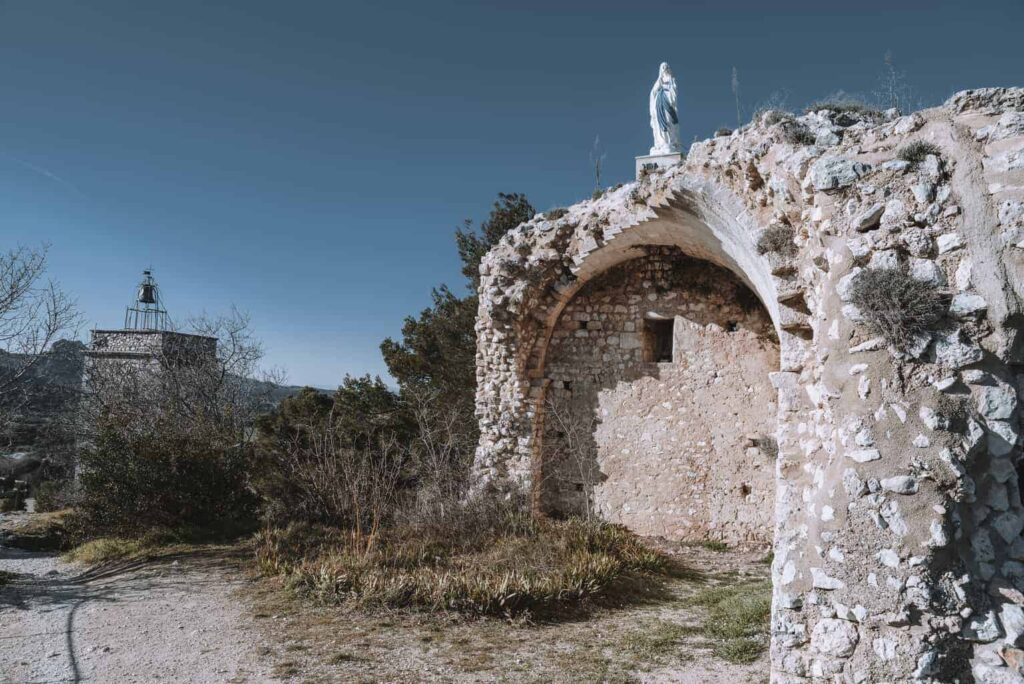
The village of Eygalières is one of the most charming villages in the Alpilles. It’s hard to say exactly what it is that sets it apart from other villages in the vicinity, but there is a certain je ne sais quoi about it.
At the top of the hillside village, you’ll find the ruins of the ancient settlement. Not much can be seen of the original castle, except the foundations and the donjon which was transformed into a prison in the 13th century.
On top of the dungeon, you’ll see the statue of the virgin mary which was placed there in 1893 to celebrate a miracle. Only there’s nothing on record to note what the miracle actually was, so you’ll have to use your imagination on that one! You’ll also be able to visit the remains of the Saint-Laurent chapel, and the clock tower that was constructed using stones from the castle in 1672.
How to reach the Eygalières castle
It’s a short walk to the old village of Eygalières, and once again you’ll be better off leaving your car in the newer part of the village. You can drive up, but it’s extremely narrow with limited parking space.
Wander past the new Saint-Laurent chapel and continue up the hill on Rue du Dr Roque until you find the walkway on your right. The stairs will deliver you directly to the château ruins.
From there, you can loop around the hill to visit the old church and continue away from the village where you’ll find a windmill-turned-dovecote. Then backtrack to the old village, or continue down the dusty track which eventually links back up with the main road into Eygalières – just be warned, it doesn’t have a verge for walking on until you reach the village boundary again.
CHÂTEAU DE CADENET
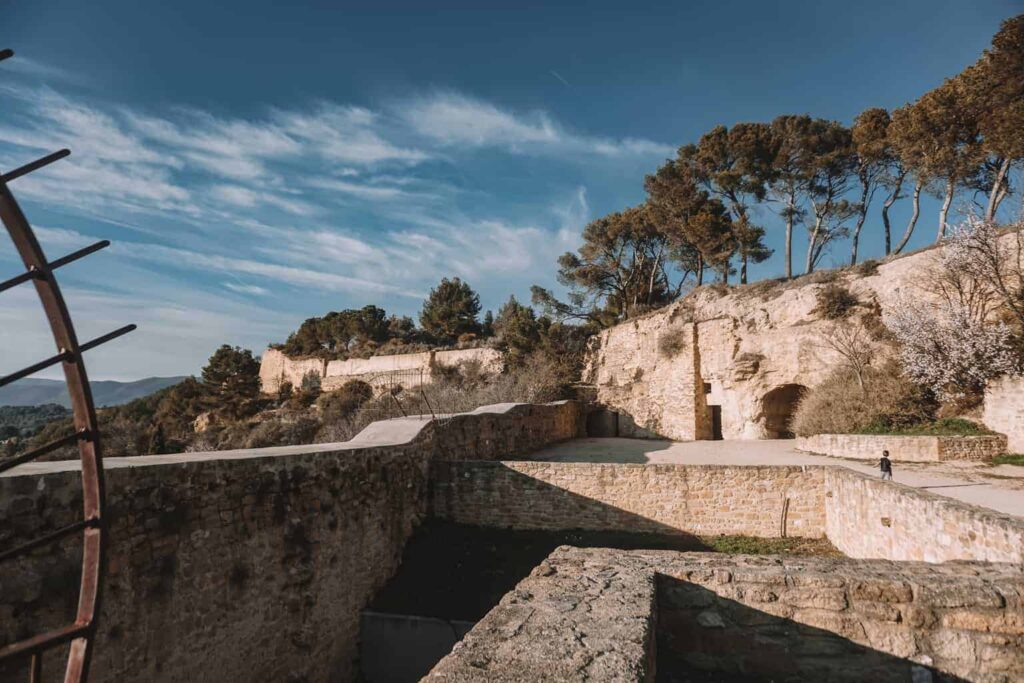
I’ve written about Château de Cadenet before, and it’s still one of my favourite castle ruins in France. The site is relatively large given the petite village that rests at its heels, and it’s a really interesting and varied place to visit.
The castle itself dates back to the 11th century and was partially destroyed in the 17th century before suffering further damage inflicted by revolutionaries in 1792. But despite its turbulent past and extensive damage, it is still a very impressive ruined castle to explore.
But what makes this place even more amazing are the troglodyte caves pockmarked around the hill that supports the château. Take your time to explore both the rooms of the castle and the prehistoric caves nearby.
How to reach this château in Provence
Hang a right at the first roundabout in the village (marked on the map above), then continue up Boulevard de la Liberté, onto Chemin des Rougettes, and then follow the signs to the ‘site du château’. This will take you to the top of the castle, where there is a small carpark and a large open field.
Alternatively, you can park at the carpark on Rue Raspail and walk to the château from there. Whichever way you arrive at the castle, be sure to visit each level in turn, ducking into caves and secret stairwells, weaving through tunnels and finishing with a walk through the wooded forest to find the hidden caves.
LE CHÂTEAU DU DUC DE GUISE (ORGON)
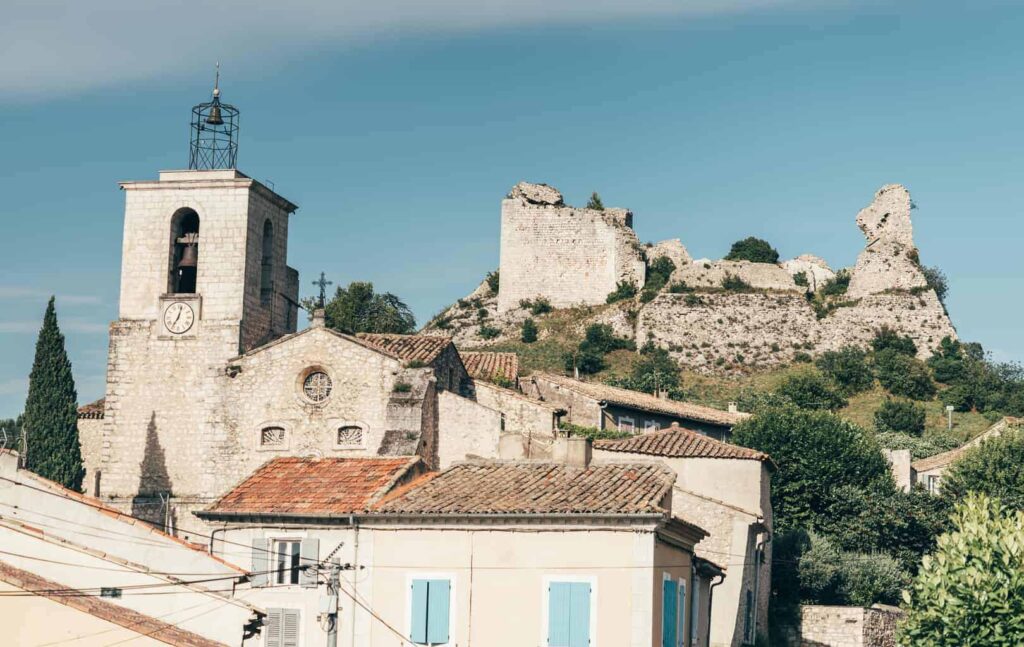
The village of Orgon sits on the edge of the Alpilles. Its unfortunate proximity to the Motorway and slightly rough-looking exterior means it often gets overlooked in favour of more secluded villages. But delve into the heart of the settlement and you’ll find a beautiful, quiet and authentic little village with plenty to offer.
Once home to a formidable castle, Orgon still has done well to preserve its heritage. Before you even enter the village the sight of the magnificent Eglise Notre Dame de Beauregard is sure to catch your eye. Situated high on a prehistoric oppidum overlooking the village, it’s well worth a visit in its own right.
Then, as you enter the village through one of the fortified gates, you’ll no doubt spot the ruins of the Château du Duc de Guise sitting high above the rooftops. It’s one of the oldest Provence castles, and as well as being very accessible, it’s a fascinating place to explore.
How to find the castle of Orgon
To reach le château du Duc de Guise, park in the village and walk through the Porte de l’Hortet – the only remaining door of the original 12th-century fortification (there are two others from a later period). From here you’ll follow a path to the château.
It’s a short but very pleasant walk around the château, or you can extend your exploration further by continuing up the hill to the Notre Dame de Beauregard church and the ruins that surround it.
CHÂTEAU DE BEAUMONT LE VIEUX
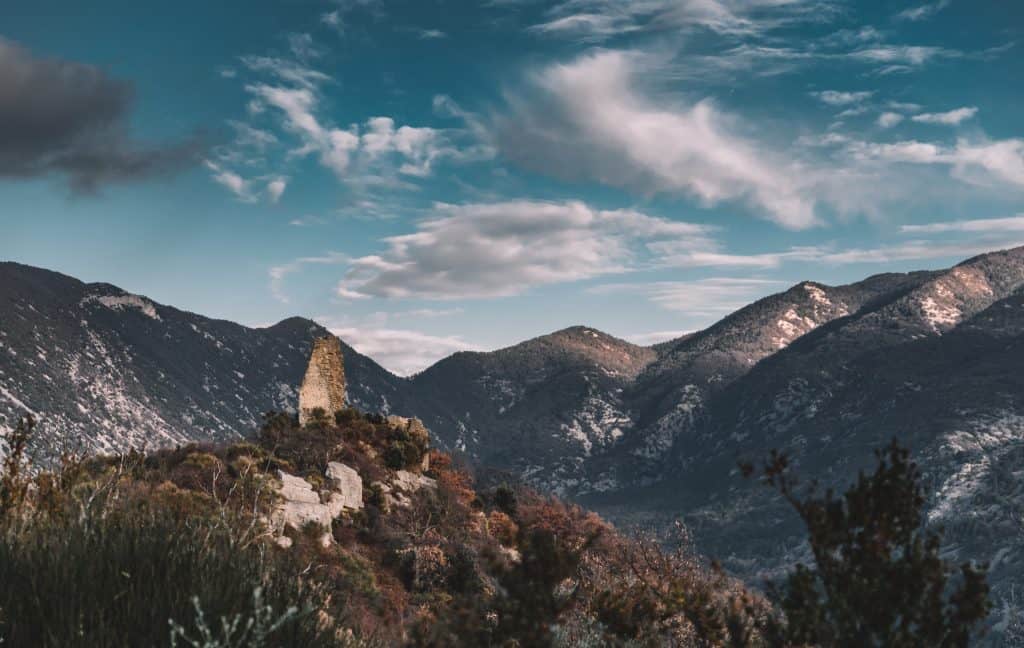
The ruins of this 10th-century castle are small in stature, but the scene that surrounds them is absolutely magical. Tucked away in a secluded valley, the Château de Beaumont le Vieux has been all but enveloped by the hill that supports it. And yet, the golden stones and crumbling tower wall that remain still manage to make a statement against the mountainous landscape.
Situated near the famous Mt Ventoux, the village of Beaumont du Ventoux isn’t actually a village in itself, but rather a series of small hamlets that make up the commune. It’s here, among the tight-knit streets and neatly plotted rows of cypress trees that you’ll find what makes this commune unlike anywhere else in Provence.
Home to the only ski station in the Vaucluse department, the undulating terrain has a different feel to the nearby Luberon Valley and is worth a visit for that reason alone. Go in the spring when the commune’s cherry crops are in full flower.
How to reach the Beaumont-du-Ventoux castle
To find this hidden castle in Provence, you’ll drive into the tiny hamlet of Sainte-Marguerite. Stop to admire the petite romanesque Sainte-Marguerite chapel and think about finding a discreet place to leave your car here as the hamlet only gets narrower the further you drive in. Continue through the narrow thread of houses and take the last street on your right. This will lead you to a stone path that indicates the start of the walk.
When we visited, we took the path up the hill past vineyards and old huts, right up to the crest of the hill. Here the path gets quite overgrown and hard to navigate. Because of this, we didn’t push on to the castle, but we were rewarded with a superb view of the ruins. On the way back down I noticed a subtle stack of rocks with a blue marker, indicating a shorter but steeper route to the castle should you wish to take that route.
LE CHÂTEAU DES ÉVÈQUES DE CAVAILLON
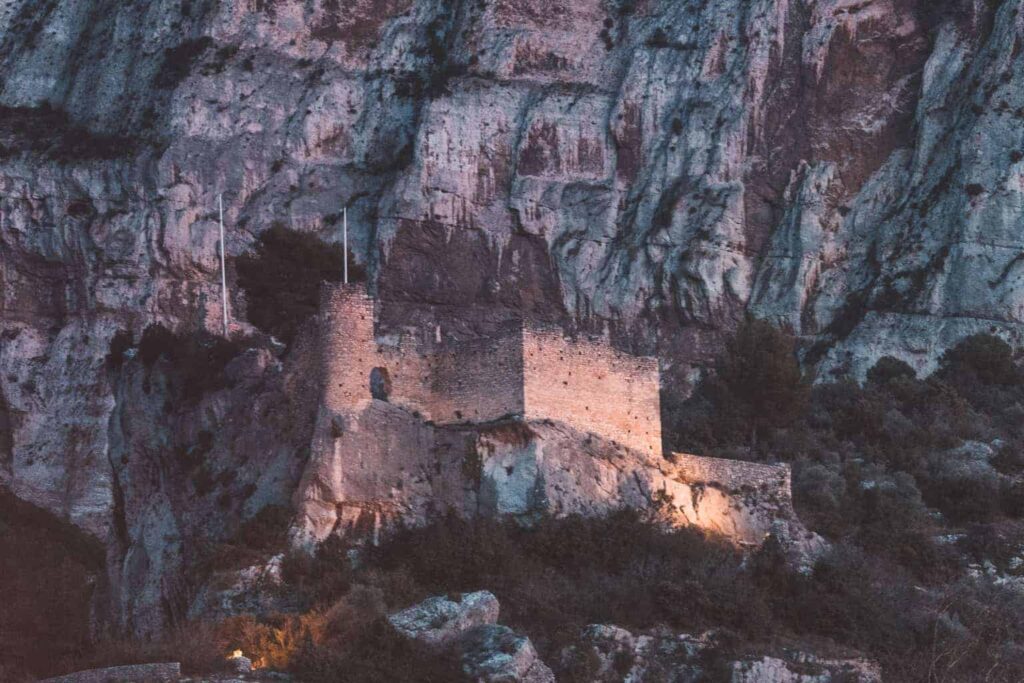
Fontaine de Vaucluse is famous for being the birthplace of the River Sorgue. Walk alongside the gently flowing river and you’ll eventually arrive at a deep spring etched into the base of a 240m cliff face. But high above the village is another remarkable sight. The Bishop’s Castle strikes an impressive figure above the petite village and it is an equally intriguing place to discover.
The original castle on this site was built in the 11th century, but the remains that you visit today date back to the 12th century. They’re in reasonably good condition (for ruins) and you can delve into the castle to peek through its windows, peer into caves, and climb ancient stairs for a magnificent vantage point of the fontaine below.
How to get to the Bishop’s Castle
Parking throughout Fontaine de Vaucluse is plentiful in supply, but you have to pay a €4 flat fee for the privilege. From any of the car parks, make your way towards the eastern side of the village, near the tourist office.
From here you can walk through a tunnel to reach the François Pétrarque museum (also worth a visit), or climb the stairway towards the château. The path is clearly marked, but it’s not without its challenges – especially for the young or elderly. There are sections where a ladder aides you to ascend a steep embankment, or where the rocks are particularly slippery. It is a short but steep climb to the castle.
Once you’ve investigated the ruined castle and its surrounds you can continue on the same path which will take you higher and higher up into the valley of the Fountain of Oule. It’s a spectacular walk, with views to match!
By visiting these ruined Provence castles, you’ll get a unique insight into the history and heritage of the region. You’ll be rewarded with secluded walks and the most spectacular views. And most of all you’ll discover a different side of Provence, one that is waiting to unveil itself to you…
Pin this for later




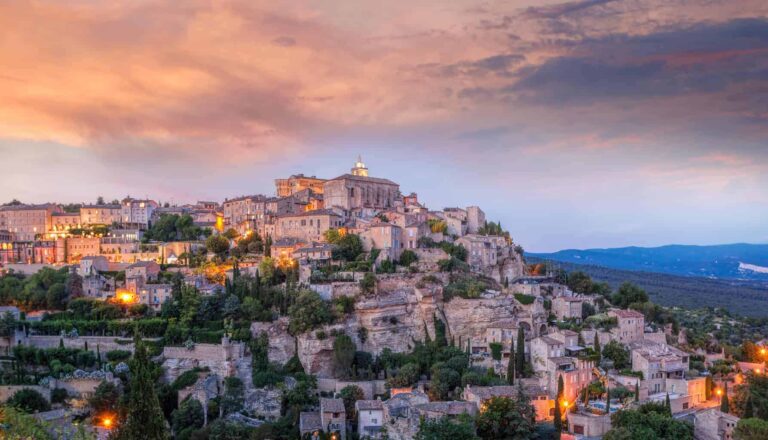
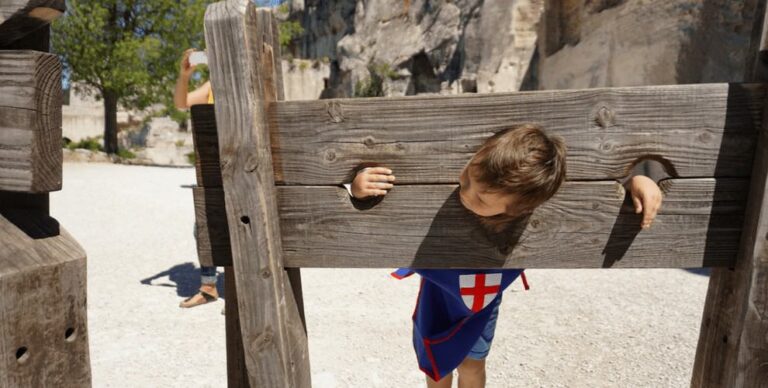
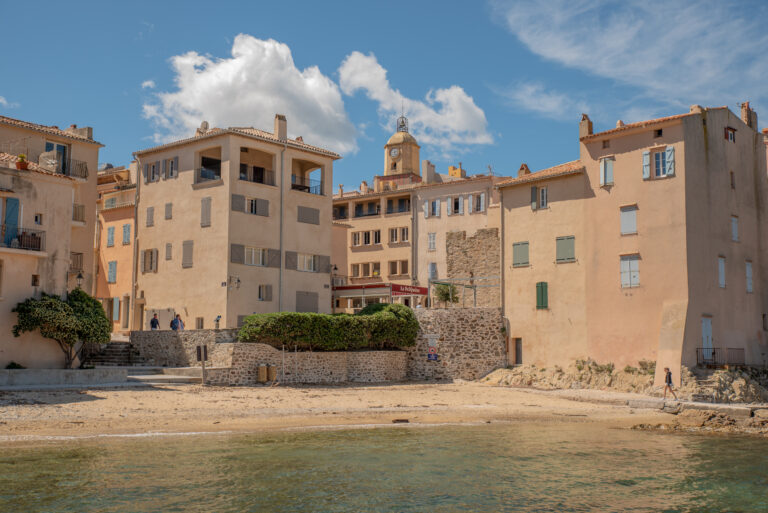
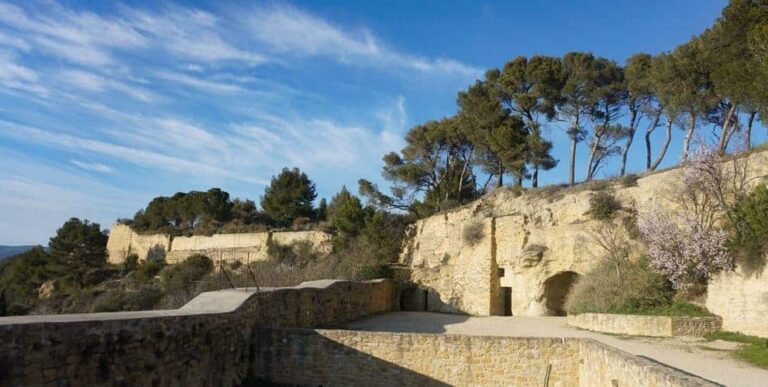

You forgot the castle at Chateaurenard… it is lovely, though a ruin.
Hi Heike, oh I haven’t yet discovered the castle at Chateaurenard – will have to get up there! These are just my personal favourites, not a comprehensive list 🙂
Thanks! The Alleine village web site is no longer available. Is their map available elsewhere?
Hi David, thanks for the heads up! I’ll update the article, but in the meantime, you can find the map here: http://www.alleins.fr/wp-content/uploads/2017/06/Alleins_au_fil_du_temps_2015.pdf
Hi Nadine, I’m trying to find a particular location in Provence that could be a castle/monastery/chapel ruin located on top of a hill. I have several pictures of parts of the building(s) and would like to send you them to see if you may recognise what and where it is exactly. Do you have a website that I can contact you on?
Hi James, no problem – email them to me at [email protected] and I’ll see if I can identify it.